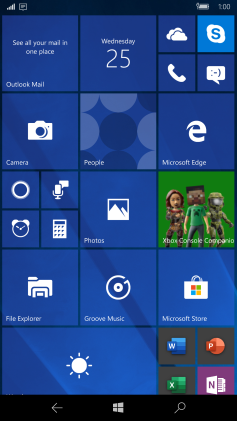Project Astoria

Screenshot of Windows 10 Mobile home screen
|
|
| Developer | Microsoft |
|---|---|
| Released to manufacturing |
November 20, 2015 |
| General availability |
March 17, 2016 |
| Latest release | 1607 (10.0.14393.693) / January 10, 2017 |
| Latest preview | 1704 (10.0.15043.0) / February 24, 2017 |
| Update method | Windows Update |
| Platforms | ARM 32-bit |
| Kernel type | Hybrid (Windows NT) |
| Preceded by | Windows Phone 8.1 (2014) |
| Official website | microsoft |
| Support status | |
| Mainstream support until October 9, 2018. Devices need to install the latest update to remain supported and be within the OEM support period. | |
Windows 10 Mobile is a mobile operating system developed by Microsoft. It is an iteration of the Windows Phone product line and a successor to Windows Phone 8.1, and is an edition of Windows 10, Microsoft's operating system for personal computers, as part of Microsoft's plans to unify Windows' application platform across multiple device classes.
Windows 10 Mobile aims to provide greater consistency with its counterpart for personal computers, including more extensive synchronization of content, a new universal application platform that allows one app to run on multiple Windows 10 devices such as PCs, mobile devices and Xbox, as well as the capability, on supported hardware, to connect devices to an external display and use a "PC-like" interface with mouse and keyboard input support. Microsoft has built tools for developers to easily port some iOS apps with minimal modifications. Windows Phone 8.1 smartphones are eligible for upgrade to Windows 10 Mobile, pursuant to manufacturer and carrier support. Some features may vary depending on hardware compatibility.
Windows 10 Mobile is designed for use on smartphones and phablets running on ARM processor architectures. Windows 10 Mobile entered public beta for selected Lumia brand smartphones on February 12, 2015. The first Lumia smartphones powered by Windows 10 Mobile were released on November 20, 2015 while eligible Windows Phone devices began receiving updates to Windows 10 Mobile on March 17, 2016, pursuant to manufacturer and carrier support.
Microsoft had already begun the process of unifying the Windows platform across device classes in 2012; Windows Phone 8 dropped the Windows CE-based architecture of its predecessor, Windows Phone 7, for a platform built upon the NT kernel that shared much of the same architecture with its PC counterpart Windows 8 including file system (NTFS), networking stack, security elements, graphics engine (DirectX), device driver framework and hardware abstraction layer. At Build 2014, Microsoft also unveiled the concept of "universal" Windows apps. With the addition of Windows Runtime support to these platforms, apps created for Windows 8.1 could now be ported to Windows Phone 8.1 and Xbox One while sharing a common codebase with their PC counterparts. User data and licenses for an app could also be shared between multiple platforms.
...
Wikipedia
